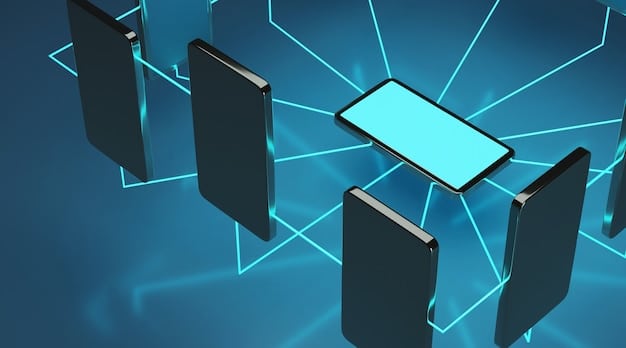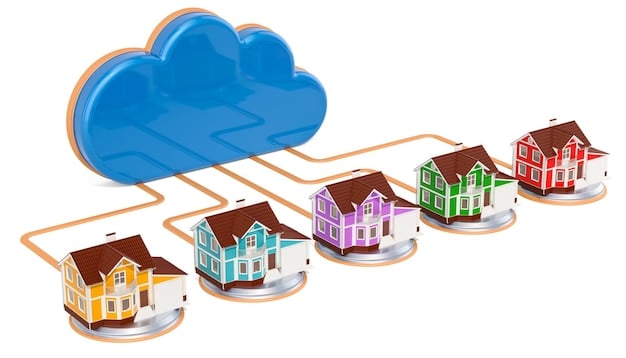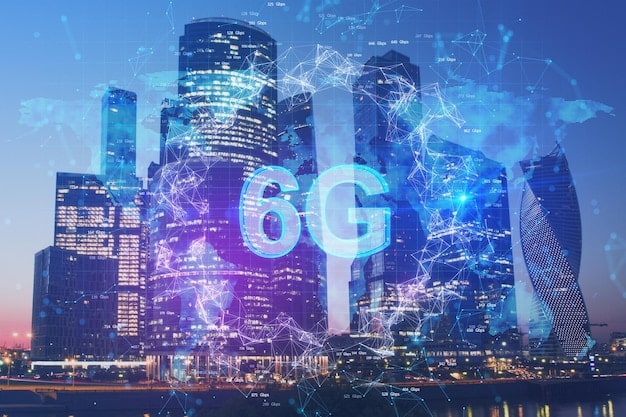Edge Computing in the US: Top 5 Trends Shaping Data Processing’s Future

Edge computing is rapidly transforming data processing in the US by bringing computation closer to the data source to reduce latency, improve bandwidth use, and enhance data security and privacy.
The rise of edge computing in the US is not just a technological shift; it’s a fundamental change in how data is processed, analyzed, and utilized. As we generate ever-increasing amounts of data, the traditional cloud computing model faces limitations in terms of latency, bandwidth, and security. Edge computing offers a solution by bringing computation closer to the source of data, enabling faster processing, reduced bandwidth consumption, and enhanced privacy.
Understanding the Edge Computing Revolution in the US
Edge computing represents a paradigm shift from centralized cloud computing to a distributed computing model. In this model, data is processed closer to where it is generated—at the “edge” of the network—rather than being transmitted to a remote data center. This proximity offers significant advantages, particularly in scenarios requiring real-time processing and low latency.
The deployment of edge computing solutions in the US is being driven by a number of factors. One of the most important is the increasing demand for faster data processing capabilities across a wide range of industries, from healthcare and manufacturing to transportation and retail. The proliferation of IoT devices, combined with the emergence of 5G networks, is further accelerating the adoption of edge computing in the US.

Key Benefits of Edge Computing
- Reduced Latency: By processing data closer to the source, edge computing minimizes the time it takes for data to travel to and from the data center. This is crucial for applications requiring real-time responses, such as autonomous vehicles and industrial automation.
- Improved Bandwidth Efficiency: Edge computing reduces the amount of data that needs to be transmitted over the network, thereby conserving bandwidth and lowering costs. This is particularly important in areas with limited or expensive bandwidth.
- Enhanced Security and Privacy: Edge computing enables data to be processed and stored locally, reducing the risk of data breaches and improving privacy compliance. Sensitive data can be kept on-premises, minimizing the exposure to external threats.
Ultimately, the rise of edge computing is about enabling a more efficient, secure, and responsive data processing infrastructure in the US. As businesses and organizations continue to embrace edge computing, they will be able to unlock new opportunities and gain a competitive edge in an increasingly data-driven world.
Trend 1: The Proliferation of IoT Devices Driving Edge Adoption
The Internet of Things (IoT) is generating massive volumes of data from diverse sources, including sensors, cameras, and industrial equipment. This data deluge is overwhelming traditional cloud infrastructure and creating a need for more local processing capabilities.
In the US, the proliferation of IoT devices is fueling the adoption of edge computing across a wide range of sectors. From smart cities and connected vehicles to industrial automation and healthcare, IoT deployments are driving the demand for edge computing solutions that can process data closer to the source and deliver real-time insights.
IoT Use Cases in the US
- Smart Manufacturing: Edge computing enables real-time monitoring of equipment performance, predictive maintenance, and efficient resource management in manufacturing plants.
- Connected Vehicles: Edge computing provides low-latency connectivity and processing power for autonomous driving, traffic management, and vehicle-to-vehicle communication.
- Smart Healthcare: Edge computing facilitates remote patient monitoring, real-time analysis of medical images, and improved healthcare delivery in remote areas.
The exponential growth of IoT devices in the US is creating a fertile ground for the adoption of edge computing. As the number of connected devices continues to increase, the need for distributed computing architectures will become even more pronounced, driving further innovation and investment in the edge computing ecosystem.
Trend 2: The Impact of 5G on Edge Computing Growth
5G technology is poised to revolutionize the way data is transmitted and processed in the US. With its ultra-fast speeds, low latency, and high bandwidth capacity, 5G is enabling new applications and use cases that require real-time data processing at the edge.
The combination of 5G and edge computing will unlock a range of possibilities across industries. From augmented reality and virtual reality to remote surgery and autonomous drones, 5G is providing the necessary infrastructure to support the most demanding edge computing applications.

Synergies Between 5G and Edge Computing
- Ultra-Low Latency: 5G’s low latency enables edge computing to deliver near real-time responses for time-sensitive applications.
- High Bandwidth Capacity: 5G’s high bandwidth allows edge computing to process large volumes of data from IoT devices, enabling more complex and sophisticated applications.
- Enhanced Connectivity: 5G provides reliable and seamless connectivity for edge devices, ensuring consistent performance and availability.
The deployment of 5G networks in the US is accelerating the adoption of edge computing and paving the way for innovative new applications. As 5G coverage expands and matures, the synergies between 5G and edge computing will become even more pronounced, driving further growth and innovation in both sectors.
Trend 3: The Rise of AI at the Edge
Artificial intelligence (AI) is increasingly being deployed at the edge to enable more intelligent and autonomous decision-making. By embedding AI algorithms into edge devices, organizations can process data locally and generate real-time insights without relying on cloud connectivity.
In the US, the rise of AI at the edge is transforming industries ranging from manufacturing and retail to healthcare and transportation. AI-powered edge computing solutions are enabling real-time anomaly detection, predictive maintenance, and personalized customer experiences.
Examples of AI at the Edge
Edge computing is revolutionizing various AI fields, including:
- Predictive Maintenance: By embedding machine learning models into edge devices, businesses can analyze real-time data from sensors and equipment, allowing for the prediction and prevention of costly downtime.
- Improved Quality and Assurance: Deploying AI algorithms on the edge has made it easier for organizations to examine product quality at every step and quickly identify possible defects.
- Smart Surveillance: The amalgamation of machine learning algorithms and video streams has made it easier to create real-time alerts for security threats on the edge.
The combination of AI and edge computing is driving a new wave of innovation in the US, enabling businesses to create more intelligent, efficient, and responsive operations. As AI algorithms become more sophisticated and edge devices become more powerful, the potential for AI at the edge will continue to expand.
Trend 4: Security Considerations in Edge Deployments
Security is a critical consideration in edge computing deployments, as the distributed nature of edge environments presents new challenges for securing data and infrastructure. Organizations need to implement robust security measures to protect against a wide range of threats, including data breaches, malware attacks, and denial-of-service attacks.
The security of edge computing deployments in the US is paramount, as businesses and organizations are increasingly relying on edge infrastructure to process and store sensitive data. A strong security posture is essential to maintain trust, protect intellectual property, and ensure compliance with data privacy regulations.
Edge Security Best Practices
Implementing effective security measures is very important in edge computing to maintain data and infrastructure safety. Here are some edge security best practices:
- Implement Zero Trust: Implement a Zero Trust edge framework to increase the security posture by verifying devices and authenticating users. That way, you can limit the surface of attacks by securing every access point.
- Harden the System: Use trusted operating systems, install security patches, remove unnecessary services and software, and encrypt storage and communication to avoid exploits in edge computing systems.
- Use Containerization: By isolating edge applications, containerization can minimize the impact of attacks and provide an additional layer of security, thus making it difficult for hackers to move across the system.
- Conduct Security Training: Make sure that your team is up-to-date on edge security with frequent training. This way, they are in a position to recognize possible threats and react properly to minimize the risks.
Organizations must prioritize security from the outset of their edge computing deployments. By implementing robust security measures and adhering to industry best practices, businesses can minimize the risks associated with edge computing and ensure the confidentiality, integrity, and availability of their data and systems.
Trend 5: Edge Computing as a Service (ECaaS)
Edge Computing as a Service (ECaaS) is an increasingly popular deployment model that allows organizations to leverage the benefits of edge computing without the need to invest in and manage their own infrastructure. ECaaS providers offer a range of services, including edge hardware, software, and management tools, enabling businesses to focus on their core competencies.
The adoption of ECaaS in the US is being driven by a number of factors, including the desire to reduce capital expenditures, simplify edge deployments, and accelerate time to market. ECaaS providers offer a pay-as-you-go model that allows organizations to scale their edge resources up or down as needed, providing flexibility and cost savings.
The Benefits of ECaaS
- Reduced Capital Expenditures: With ECaaS, organizations can avoid the upfront costs associated with building and maintaining their own edge infrastructure.
- Simplified Deployments: ECaaS providers handle the complexity of deploying and managing edge infrastructure, freeing up organizations to focus on their business applications.
- Scalability and Flexibility: ECaaS offers a pay-as-you-go model that allows organizations to scale their edge resources up or down as needed, providing flexibility and cost savings.
ECaaS is making edge computing more accessible to a wider range of organizations in the US. By providing a simplified and cost-effective deployment model, ECaaS is accelerating the adoption of edge computing and enabling businesses to unlock new opportunities and create innovative solutions.
| Key Point | Brief Description |
|---|---|
| 🚀 IoT Proliferation | Increased data from IoT devices drives the need for localized edge processing. |
| 📶 5G Impact | 5G’s enhanced connectivity boosts edge computing for real-time applications. |
| 🧠 AI at the Edge | AI integration enables intelligent decision-making at the edge, reducing cloud reliance. |
| 🛡️ Security | Security measures are crucial to protect distributed edge environments from threats. |
FAQ
▼
Edge computing is a distributed computing paradigm that brings computation and data storage closer to the location where it is needed, to improve response times and save bandwidth.
▼
5G provides the high-speed, low-latency connectivity necessary for edge computing to thrive, supporting real-time applications that demand immediate processing and response.
▼
Edge computing introduces security challenges due to its distributed nature. Protecting edge devices and data requires robust measures such as encryption, access control, and continuous monitoring.
▼
AI at the edge enables faster decision-making, reduced latency, and enhanced privacy by processing data locally rather than sending it to the cloud for analysis.
▼
ECaaS provides edge computing resources on a pay-as-you-go basis, which reduces upfront costs, simplifies deployments, and allows organizations to scale their edge infrastructure as needed.
Conclusion
The rise of edge computing in the US is a transformative trend with far-reaching implications for businesses and consumers alike. By bringing computation closer to the source of data, edge computing is enabling faster processing, reduced bandwidth consumption, and enhanced security. These five key trends—the proliferation of IoT devices, the impact of 5G, the rise of AI at the edge, security considerations, and ECaaS—are shaping the future of data processing in the US and driving the adoption of edge computing across a wide range of industries.





